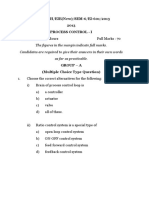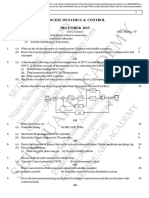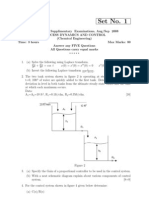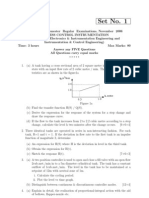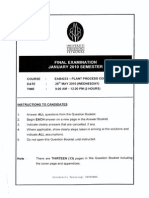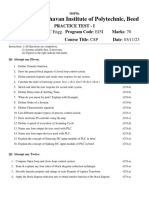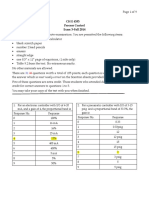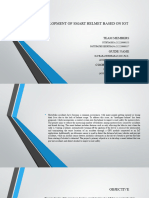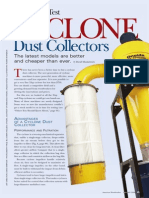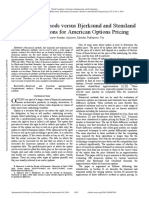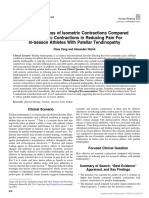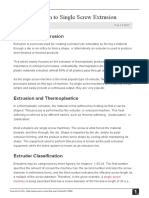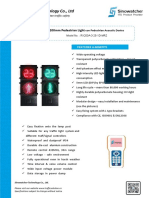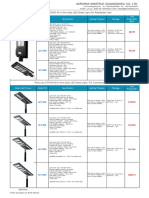B.
TECH/AEIE/5TH SEM/AEIE 3101/2022
B.TECH/AEIE/5TH SEM/AEIE 3101/2022
PROCESS CONTROL
(AEIE 3101)
Time Allotted : 3 hrs Full Marks : 70
Figures out of the right margin indicate full marks.
Candidates are required to answer Group A and
any 5 (five) from Group B to E, taking at least one from each group.
Candidates are required to give answer in their own words as far as practicable.
Group – A
(Multiple Choice Type Questions)
1. Choose the correct alternative for the following: 10 × 1 = 10
2𝑠+1
(i) A system with transfer function is of ________ order.
4𝑠
(a) zero (b) 1st (c) 2nd (d) 3rd
(ii) When the damping co-efficient (ξ) is unity, the system is
(a) Overdamped (b) Critically damped (c) Underdamped (d) Highly fluctuating.
(iii) Presence of derivative control in a process
(a) Reduce the noise (b) Enhance noise
(c) Not sensitive to noise (d) Accumulate the noise
(iv) Better controllability will achieve if
(a) Dead time and time constant are same
(b) Dead time is higher than time constant
(c) Dead time is smaller than time constant
(d) None of these.
(v) The transfer function for a P-D controller is
(a) 𝐾𝑐 (1 + 𝜏𝐷𝑠) (b) 𝐾𝑐 (1 + 1/𝜏𝐷𝑠) (c) 𝐾𝑐 𝜏𝐷𝑠 (d) 𝐾𝑐 /𝜏𝐷𝑠.
(vi) A proportional controller with a gain of Kc is used to control a first order process.
The offset will increase, if
(a) Kc is reduced (b) Kc is increased
(c) Integral control action is introduced (d) Derivative control action is introduced.
(vii) Cavitation occurs in control valve
(a) Before flashing occurs
(b) After flashing occurs
(c) When the pressure recovers to a point greater than its vapour pressure
(d) Both (b) & (c)
(viii) Flapper nozzle is used in a/an __________ controller.
(a) Electronic (b) Hydraulic (c) Pneumatic (d) None of these
AEIE 3101 1
�B.TECH/AEIE/5TH SEM/AEIE 3101/2022
(ix) PLC operation sequence are
(a) Self-check, Input scan, output scan, logic solve, self-check
(b) Self-check, logic solve, output scan, Input scan, self-check
(c) Self-check, output scan, Input scan, logic solve, self-check
(d) Self-check, Input scan, logic solve, output scan, self-check.
1 2s
(x) The transfer function [ Gc (s) Kc ] describe which type of controller?
s
(a) PID (b) PD (c) P (d) PI.
Group- B
2. Draw a level tank with an input flow line and an outlet flow line fitted with a linear
restrictor R. Assume input flow rate as Fi , output flow rate as Fo and area of the tank is A.
At any instant the liquid level in the tank is h.
(i) State the conservation principle necessary to build the mathematical model of the
above process and hence build the process model.
[(CO1)(Understand/LOCQ), (Analyse/IOCQ)]
(ii) Calculate and draw the dynamic response of Fi when a unit step change is applied. How
will the response change if the output restrictor is opened more?
[(CO1)(Apply, Analyse/IOCQ)]
(1 + 4) + (4 + 3) = 12
3. (a) Define a process dead time. In the presence of dead time, how will the transfer
function of a first order process be modified? Draw the process's dynamic responses
without and with dead time. [(CO5)(Understand/LOCQ), (Apply/IOCQ)]
(b) Draw the P&I diagram for a Flow control loop following ISA standard.
[(CO1)(Apply/IOCQ)]
(c) Explain overspecified process with respect to degrees of freedom.
[(CO2)(Analyse/IOCQ)]
(1 + 4) + 4 + 3 = 12
Group – C
4. (a) Describe operation of a two-step controller with necessary schematic diagram. State
the disadvantages of such controller. [(CO2)(Understand/LOCQ)]
(b) Define offset error. State two different way to reduce offset error.
[(CO2)(Remember/LOCQ)]
10
(c) Consider a process with transfer function 𝐺𝑃 (𝑠) = . State whther the system is
𝑠−1
stable or not. Demonstrate that the process's close loop response can be made stable
using a proportional controller. Determine the proportional gain for which the close
loop response is stable. [(CO2)(Evaluate/HOCQ), (Understand/LOCQ)]
(3 + 1) + (1 + 2) + (4 + 1) = 12
5. (a) Draw a block diagram of a digital control system and explain each block.
[(CO3)(Understand/LOCQ)]
AEIE 3101 2
�B.TECH/AEIE/5TH SEM/AEIE 3101/2022
(b) What do you mean by process reaction curve? Explain how you can use this to tune
the controller parameters? [(CO3)(Apply/IOCQ)]
(c) Draw block diagram for a self-tuning regulator. [(CO3)(Understand/LOCQ)]
4 + (1 + 4) + 3 = 12
Group – D
6. (a) Which type of control valve should be used for a process, in which the pressure drop
across the valve is expected to be relatively constant? Draw and explain the
characteristics of the chosen valve. [(CO4)(Apply/IOCQ)]
(b) The incoming liquid may be acidic or base and must be neutralised in a pH-controlled
process. Suggest and describe the appropriate valve sequencing for the
aforementioned event. Create a P&I diagram of the control scheme that will be used
to solve the stated problem. [(CO5)(Apply/IOCQ), (Create/HOCQ)]
(c) Draw the valve signature for an air to open globe valve. [(CO4)(Understand/LOCQ)]
4 + (3 + 3) + 2 = 12
7. (a) Distinguish between cage guided and stem guided control valve.
[(CO4)(Analyse/IOCQ)]
(b) Draw the ideal linear control valve characteristics. How will these characteristics be
altered in the presence of mechanical friction inherent in the control valve?
[(CO4)(Analyse/IOCQ)]
(c) Describe the operation of an electro pneumatic positioner.
[(CO4)(Understand/LOCQ)]
4 + 4 + 4 = 12
Group – E
8. (a) Assume a process with a well-defined Transfer Function and also the main
disturbances are measurable. Suggest the best control scheme for such process and
describe the scheme with necessary block diagram. [(CO5)(Evaluate/HOCQ)]
(b) Construct and explain a control scheme in which the control loop monitors more
than one control variable. [(CO5)(Analyse/IOCQ)]
(c) Specify the conditions under which a feed-forward control scheme should be used.
[(CO5)(Understand/LOCQ)]
5 + 4 + 3 = 12
9. (a) Describe the functional block diagram of the PLC input module.
[(CO6)(Remember/LOCQ)]
(b) Create a PLC ladder logic diagram for sequential motor control using start and stop
push buttons for the following sequence. The start push button activates motor-1,
followed by motor-2 after 5 seconds. Motor-3 starts 10 seconds after motor-2 starts.
The stop button disables all motors. [(CO6)(Apply/IOCQ)]
(c) Analyse the operation of an Up Counter in a PLC using the timing diagram.
[(CO6)(Analyse/LOCQ)]
4 + 4 + 4 = 12
AEIE 3101 3
�B.TECH/AEIE/5TH SEM/AEIE 3101/2022
Cognition Level LOCQ IOCQ HOCQ
Percentage distribution 33.33 54.17 12.50
Course Outcome (CO):
After the completion of the course students will be able to
1. Develop mathematical model of the liquid, thermal and gas systems by their knowledge
of Mathematics, Science and engineering and analyze the process response.
2. Explore the controller modes and analyse the close loop response of the 1st and 2nd
order process in presence of P, PI, PD, PID controllers.
3. Design and simulate the ON-OFF, P, PI, PID controllers with the electronic components
and software like simulink, LabVIEW etc.
4. Select the control valve necessary to provide engineering solutions of various societal,
professional & environmental responsibilities if imposed.
5. Identify, formulate/model, analyze the process and provide solution using knowledge
of complex control systems like feed forward, cascade, ratio, override, split range and
multivariable process control.
6. Design and develop the ladder logic program in PLC for the solution of the sequential
events performed in industry.
*LOCQ: Lower Order Cognitive Question; IOCQ: Intermediate Order Cognitive Question;
HOCQ: Higher Order Cognitive Question
AEIE 3101 4


